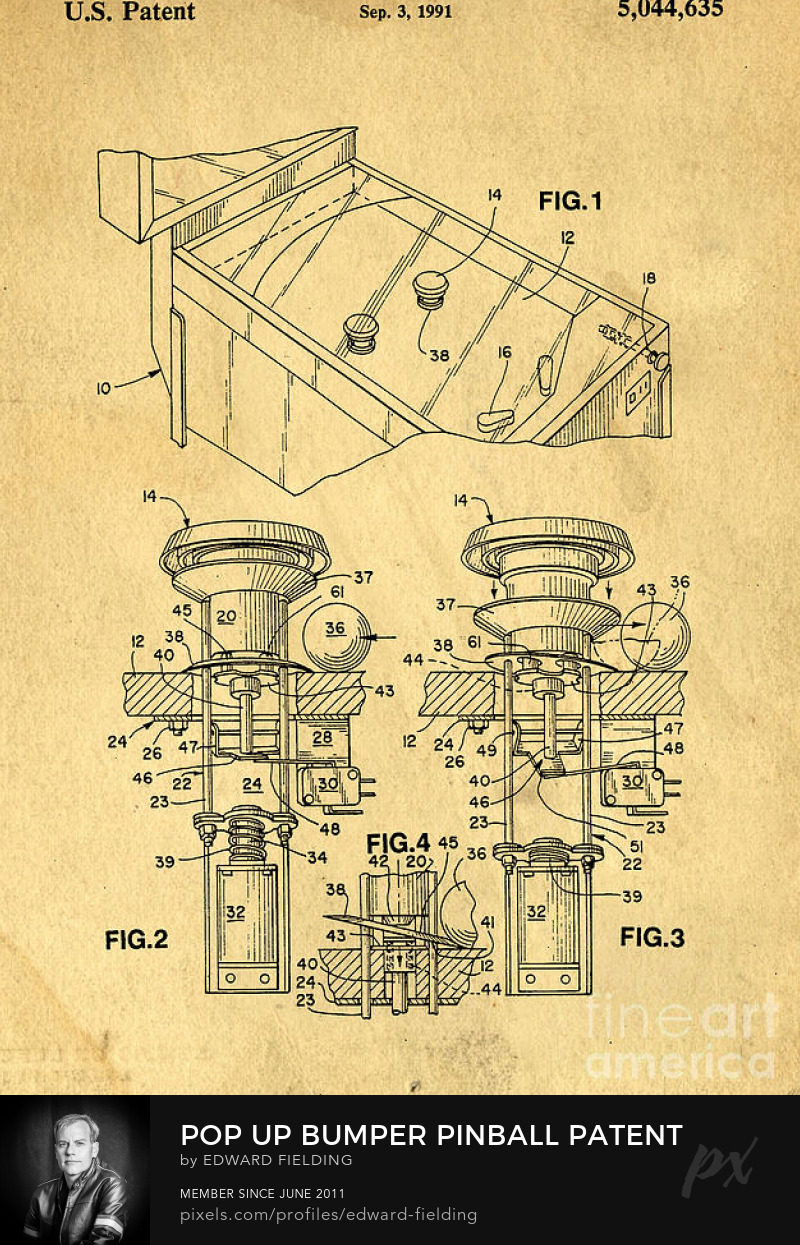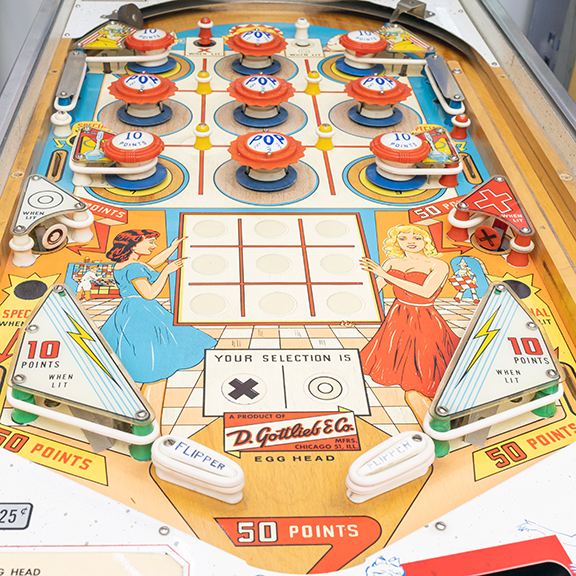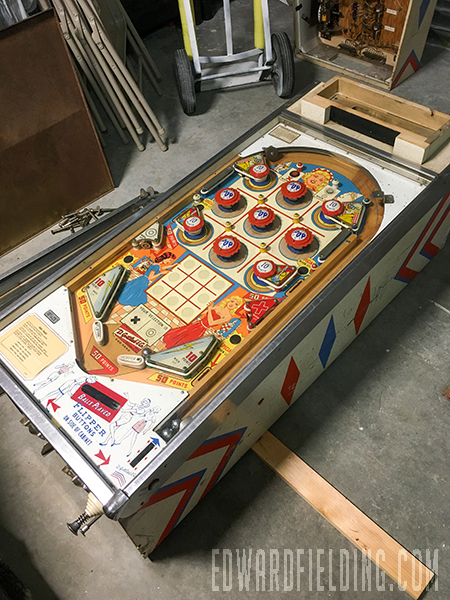
Reference Material:
Gottlieb’s “Egg Head”
==========
Date: 11/1961
=========
Prod #184
=========
Ref Back Box
Ref Cabinet
Ref Flyer
Ref Promo-BW
Ref Promo-BWG
Ref Under PF
Log 1: Ordered a replacement power cord.
The original is nothing more than a two-wire lamp cord. I replace them with a 3-prong to add a ground wire.

The initial inspection found a surprisingly clean cabinet with a few issues. One corner was coming apart – glued and clamped.
There was a hole in the bottom of the cabinet. Somewhere along the line someone must have lost the key and rather than drilling out the lock, decided to cut a hole in the bottom of the cabinet. They nearly cut through one of the wires. Soldered on a new wire.
One loose wire was found and reattached.
EOS (end of stroke switch) on one of the pop bumpers was not making contact when the pop bumper was activated. Adjusted switch with a switch adjustment tool.
Generally gave all contacts a quick clean with 91% alcohol and cotton swaps. Vacuumed out the interior. Took off playfield elements. Metal pieces went into the tumbler. Plastics got a soak in warm soapy water.
The apron was wiped down but without any alcohol which can destroy the paint. Alcohol will dissolve latex.
Playfield wiped down.

Painting the Cabinet
Ok back from vacation, time to tackle painting the cabinet. I decided the cabinet was in too bad of shape to leave as is – some purists probably disagree but I went for it.
I traced the pattern on tracing paper for later. Sanded down the cabinet. Amazingly the sides were not plywood but actual strips of wood bond together! More amazing quality in the pinball machines of this era.
Clamped and glued the corner. Fixed the hole in the bottom. Filled in the deep gouges and scratches with Plastic Wood wood filler.
Sanded again. Filled in some more. Sanded again. Sprayed on some primer and then a few coats of chalky white spray paint.
Then I attempted to recreate the stippling pattern of the original with silver paint and an old toothbrush. Unfortunately, I started to channel my inner Jackson Pollock and went a bit overboard.
At first, I liked it but the silver dried darker than the original and my spots were larger than the original and after sleeping on it I decided the effect was just too much so I sanded it down again to the primer level.
I don’t think I’ll bother with the stippling. It’s just too easy to mess up and then you have to start all over again.
I decided to give the stippling another try and put on a subtler pattern. I think it came out great this time. I’ll let the base layer cure over the weekend before putting on the red and blue pattern.
In between layers I’ve been working on installing the new power cord and soaking some parts in Evaporust.
Playfield Restoration
I’ve been cleaning the playfield with microfiber cloths, Novus 2 and Naphtha.
Also carefully working a Magic Eraser and Naphtha (use in well-ventilated area) to remove old wax, grime, and ball swirl marks. If you are going to clear coat the playfield, Magic Eraser can get the grime out of those little cracks but it can sand down the clear coat.
Don’t use water as it can get into cracks and expand which will cause paint to flack off. If you use alcohol, get 91% alcohol. Note: alcohol can dissolve some old lacquer clear coats. Don’t get it anywhere near the apron as it will dissolve the paint.
Clean up the white haze left by the Magic Eraser or what’s left of the Novus 2 with Naphtha, Then put on a nice layer of Blitz wax.
Vaccum, Naptha, Novus 2 (mildly abrasive) if needed, Magic Eraser if need (abrasive so go slowly) and then Blitz or other carnuba paste wax without silicone.
Warning: Naptha is flammable. Don’t smoke around it!
Removing the “wood grain” pop bumper protectors
At some point, someone added these “wood grain” effect vinyl pop bumper protectors to the game. Glad they did and they were surprisingly easy to remove especially on a very hot day. Naptha took care of the sticky residue.


Underneath the fake woodgrain overlay, the playfield looked as good as the rest of the playfield. I’ll probably add clear pop bumper protectors later.
After getting the old wax and dirt off of Egg Head and then buffing off the residue of the Novus 2 with a cloth, it shined up really nice. Seems like most of the original clear coat is still intact.
This machine must not have gotten a lot of action on location. I suspect it might be because it came out around the time they were phasing out the manual ball lift and starting to go with an automatic ball feeder. This machine might have looked old in the arcade once the new ones came out.
I was thinking I’d need to lay down a clear coat but now I’m thinking maybe just a good waxing will be fine. Plus adhesive clear mylar pop bumper protectors. I don’t expect this game to get a ton of plays, it’s more of a conversation piece.

I needed to use a Miracle Eraser to really clean up the grime on Egg Head. It will need a clear coat now.
Cabinet Repaint

Cabinet sanded down, Scratches filled. Sanded. Primed. Sanded, Two coats of antique white. Stippled with silver acrylic and an old toothbrush. Allowed to cure for several days.
Stencils were made before sanding off the old paint. Transfering the simple geometric pattern stripes and diamonds.
Note: The original stencils used at the factory were made of thin brass. I’m using tape. The lines will probably come out sharper than the original with usually has a bit of overspray. Trying not to put the paint on too thick. I don’t want any ridges.
Note that the stippling comes after the white base layer, not on top of everything. Hopefully, the tape won’t pull up any paint.
What do I listen to when spray painting? It has to be “Social Distortion – Live at the Roxy” Badass blues-punk-rock! Great stories, tragic tales, great humor!
You got bad, bad luck
Bad, bad luckSome people go to church on Sundays,
Others they pray at home.You tell them that there ain’t no God,
Selected lyrics from “Bad Luck”
That they’re better off standin’ alone.
You’re always scratchin’ at the eight ball,
No one really knows the reason why.
You get to the top and then you fall,
Gonna hang down your head and cry
Song by Social Distortion
August 2 – Continuing to paint the cabinet. It’s slow going. Using spray paint can be really irritating as it seems to find a way around masking! I’ve had to redo sections that got a faint dusting of blue under the masking.
As I work on painting the head I’m moving everything sticking up
on the playfield underneath so I can clean and clear-coat.
Had one solder joint pop off. Fixed that.
Found a missing screw on the relay bank solenoid – so it wasn’t in
the proper position. Fixed that.
Taking the pops off. I’ll probably end up ordering new plastic
bodies? Maybe.
Painting continues to be frustrating – wait 48 hours between coats or you’ll end up with cracking – especially during these humid days!
Meanwhile, preparing the playfield for cleaning, touch up and clear coating.

Blue tape blocks holes and secures loose parts. Screws go into the tumbler for a shine. Had to unscrew and lift that massive reset bank of relays to get at some parts underneath.
This machine is in amazing condition – so clean. Must have gone into a home very soon after purchase.

The plan is to clamp down a piece of 1/4 plywood or MDF to the front and use a flush trim router bit to cut out the side and sides. Also known as a pattern bit the bit will make a flush cut as the bearing rolls along the edge of the pattern.
These trim/pattern bits are available with bearings on the top, on the bottom or on both top and bottom. There are even plunge ones with a sharp end so you can plunge in (or just drill a hole to get started).
Just measure the depth so that the bearing rides on the pattern. In my case, I’ll be using a bit with the bearing on the bottom. After cutting out the large inside hole, I’ll run the router around the edge to cut the outside. I’ll make some practice cuts first before attempting.
I’ve been listening to some great blues in the shop – Alligator Records—50 Years Of Genuine Houserockin’ Music
How to Cut a Wedgehead “Window” using a router and pattern cutting bit
To do this, I cut the front face to a rough approximation of the final size and then trimmed it to the exact size on both the inside and the outside with a router and a bit known as a pattern cutting or flush cutting bit.
A pattern cutting bit is just a straight bit with a guide bearing on either the top or the bottom. The bearing is exactly the same diameter as the cutter, so you put your pattern above or below the piece you are cutting. The location of the pattern is dictated by the location of the bearing, so if you have a bottom bearing, the pattern needs to be on the bottom. In this instance, since the head itself will be used as one of the patterns, I used a bit with the bearing on the bottom.
I used a sheet of ¼” birch plywood to make the new face from. I laid the old piece on top of the new plywood and traced both the inside and outside. For the initial cut, close counts.
In fact you need to leave about ¼” on every dimension to allow for the final trimming. I cut out the outside of my Wedgehead face with a table saw and used a portable jig saw for the inside. I could have just as easily used a jigsaw for everything. Just be sure to leave a little extra on all sides.
The next step is to trim the inside or window hole to the exact size. Clamp the old piece, the pattern, underneath the new piece. Make the necessary adjustments to the router depth to make sure the bit stays piloted on the old piece, turn on the router and make the final trim on the window. There are a few things to be careful of during this step.
The next step is to trim the inside or window hole to the exact size. Clamp the old piece, the pattern, underneath the new piece. Make the necessary adjustments to the router depth to make sure the bit stays piloted on the old piece, turn on the router and make the final trim on the window. There are a few things to be careful of during this step.
One thing to be careful of is that you need to make sure the router is being fed in the correct direction relative to the rotation of the bit.
The router spins clockwise so you need to move the router in a clockwise direction. This is done to avoid a “climb cut” where the bit rotation actually pulls the router along. This can lead to an out-of-control, poor cut and can even be a little dangerous.
Note that the feed direction will be reversed when you are trimming the outside of the face. Be careful and make sure you are feeding it in the correct direction. The direction you move the router or the workpiece should always be such that the router bit rotation opposes movement.
The actual feed direction will change depending on if you are routing the inside of a frame, the outside of a frame, if you are moving the router (freehand) or the piece itself, as when using a router table. The key is that the rotation of the bit cannot “help” the movement of either the wood or the router, whichever you are moving.
The other thing you will run into is that you will need to reposition the clamps at some point. The router cannot cut where the clamps are, so you will need to add new clamps, AND THEN pull off the old ones.
This will retain your alignment. Some people use two-sided tape to avoid this issue, but I don’t trust the stuff. So route out as much as you can, put new clamps on, remove the old clamps, and then finish routing the window where the clamps were.
At this point the inside or “window” is complete and the outside needs to be trimmed to size.
newmantjn on Pinside
Pinball Machine Tools – Nut Drivers
I wanted to stop for a moment to mention some of my favorite tools for working on these old pinball machines.
Nut drivers are needed to tighten or remove lots of various parts on a pinball machine. Make sure you get ones that have hollow shafts. I love this set from Klien tools that feature 7-in-1 or get a set of individual nut drivers.








Tips on clear coating with Varathane.
- Waterbased “interior” version of Varathane gloss is fine.
- Carefully clean the surface. Make sure there is no silicone based products on it.
- Level the playfield. Varathane is self-leveling.
- Cover any holes with tape from below.
- Read the can and heed the ventalition warnngs. Wear a good mask.
- Spray on thin initial layer. Let dry one hour plus before the next layer. 4 thin layers is the minimum.
- Varathane will look milky if sprayed on too thick but should dry to crystal clear.
- I did do some experimenting with another playfield. Spraying leaves a slight orange peel source. Brushing on with a foam brush seems to give a flatter finish since the Varathane is self-leveling.


Pop Bumpers!
There are nine pop bumpers on Egg Head! Five active ones that have metal sleeves that pull down and push the ball away and four “dead” bumpers that just score points.
All of the plastics on Egg Head were in a rather good shape for the machine’s age and I wanted to preserve as much as the old “marbleized” plastic as I could so I kept the old posts and the pop bumper skirts and caps.
I had to order new white bases and white bodies as a few were cracks and discolored. The only problem – caps on the four dead pop bumpers don’t fit on the new bodies. The active bumper caps screw on – they fit but the dead pop bumper caps are supposed to snap on and the bodies are too big.
Ironically the old bodies were too small due to shrinkage over time and from the heat of the bulb. In fact, the previous owner had put in some colored electrical tape around the top of the bodies for a more snug fit.
Seems the solution is going to be to run some sandpaper around the bodies to make them thinner. If that doesn’t work, some daps of hot melt glue or some of that blue putty used to hang posters will be employed.
That worked! I used a rotary tool with some sandpaper to sand down the edge until I could pop on the pop bumper caps.
Fixing Light Sockets
Decades old light sockets can lead to flicking lights, lights not working at all and dim lit bulbs.
I followed this excellent guide to pinball light socket repair – https://homepinballrepair.com/repair-pinball-lamp-sockets/
